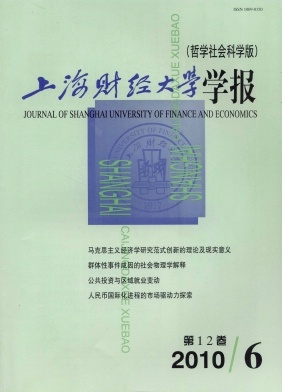收入分配对储蓄率的影响研究述评
上海财经大学学报 2010 年 第 12 卷第 06 期, 页码:91 - 98
摘要
参考文献
摘要
本文从如下几个方面梳理了收入分配对储蓄率影响的文献并进行了评述。首先,本文回顾以往理论文献中关于收入分配对储蓄率影响的不同观点与理论发展;其次,本文总结以往文献中基于微观与宏观数据的经验研究;再次,本文讨论未来可能的理论与实证研究前景;最后,本文从分析我国收入分配不均与高储蓄率并存现象的现实入手,揭示收入分配扭曲可能正是中国储蓄率上升的原因。
[1]Alesina,A.,and Perotti,R..Income Distribution,Political Instability,and Investment[J].European E-conomic Review,1996,40,1203-1228.
[2]Alesina,A.,and Rodrik,D..Distributive Politics and Economic Growth[J].Quarterly Journal of Eco-nomics,1994,109,465-490.
[3]Becker,G..Human Capital,NBER,Cambridge,1975.
[4]Bernheim,D.,and Scholz,J.K..Private Saving and Public Policy[C].in Tax Policy and the Economy,7,edited by James Poterba,MIT Press,Cambridge and London,1993.
[5]Blinder,A..Distribution effects and the aggregate consumption function[J].Journal of Political Economy,1975,87,608-626.
[6]Browning,M.,and Lusardi,A..Household saving:Micro Theories and Micro Facts[J].Journal of Eco-nomic Literature,1995,34,1797-1855.
[7]Bunting,D..Savings and the distribution of income[J].Journal of Post Keynesian Economics,1991,14,3-22.
[8]Carroll C.,and Kimball M..On the concavity of the consumption function[J].Econometrica,1996,64(4),981-992.
[9]Cook,C..Saving Rates and Income Distribution:Further Evidence from LDCs[J].Applied Economics,1995,27,71-82.
[10]Della Valle,P.,and Oguchi,N..Distribution,the Aggregate Consumption Function,and the Level ofEconomic Development:Some Cross-country Results[J].Journal of Political Economy,1976,84,1325-1334.
[11]Diamond,P.,and Hausman,J..Individual Retirement and Savings Behavior[J].Journal of Public Eco-nomics,1984,23,81-114.
[12]Dynan,K.E.,Skinner,J.,and Zeldes,S.P.Do the Rich Save More?[J].Journal of Political Economy,2004,112(2),397-444.
[13]Edwards,S..Why are Latin America’s Saving Rates so Low?:An international Comparative Analysis[J].Journal of Development Economics,1996,51(1),5-44.
[14]Friedman,M..A Theory of the Consumption Function[M].Princeton University Press,1957.
[15]Guha,B.,and Guha,A.S..Target Saving in an Overlapping Generations Model[C].East Asian Bureauof Economic Research Macroeconomics Working Papers 1520,2008.
[16]Gupta,K..Foreign Capital,Income Inequality,Demographic Pressures,Savings and Growth in Devolop-ing countries:A Cross Country Analysis[J].Journal of Economic Development,1985,10(1),63-88.
[17]Hubbard,R.G.,Skinner,J.,and Zeldes,S.P.Precautionary Saving and Social Insurance[J].Journal ofPolitical Economy,1995,103,360-399.
[18]Jin,Ye,Li,Hongbin and Wu,Binzhen.Income Inequality,Status Seeking,Consumption and Saving Be-havior[C].Tsinghua University Working Paper,2009.
[19]Kaldor,N..Alternative Theories of Distribution[J],Review of Economic Studies,1955,23(2):83-100.
[20]Keynes,J.M.General Theory of Employment,Interest and Money[M].Harcourt Brace&Company,New York,1936.
[21]Lewis,W.A..Economic Development with Unlimited Supplies of Labor[J].The Manchester School,1954,22,139-191.
[22]Menchik,P.,and David,M..Income Distribution,Lifetime Savings,and Bequests[J].American Eco-nomic Review,1983,73,672-690.
[23]Musgrove,P..Income Distribution and the Aggregate Consumption Function[J].Journal of PoliticalEconomy,1980,88,504-525.
[24]Pasinetti,L..Rate of Profit and Income Distribution in Relation to the Rate of Economic Growth[J].Re-view of Economic Studies,1962,29,267-279.
[25]Perotti,R..Growth,Income Distribution,and Democracy:What the Data Say[J].Journal of EconomicGrowth,1996,1,149-187.
[26]Persson,T.,Tabellini,G..Is Inequality Harmful for Growth?:Theory and evidence[J].American Eco-nomic Review,1994,84,600-621.
[27]Samwick,A..Tax Reform and Target Saving[J],National Tax Journal,1998,51,621-635.
[28]Schmidt-Hebbel K.and Serven,L..Does Income Inequality Raise Aggregate Saving?[J].Journal of De-velopment Economics,2000,61,417-446.
[29]Smith,D..International Evidence on How Income Inequality and Credit Market Imperfections Affect Pri-vate Saving Rates[J].Journal of Development Economics,2001,64,103-127.
[30]Stoker,T..Simple Tests of Distributional Effects on Macroeconomic Equations[J].Journal of PoliticalEconomy,1986,94(4),763-795.
[31]Walther,H..Competitive Conspicuous Consumption,Household Saving and Income Inequality[C].Vien-na University of Economics and Business Administration Working Paper 40,2004.
[32]陈宗胜,周云波.非法非正常收入对居民收入差别的影响及其经济学解释[J].经济研究,2001,(4).
[33]世界银行.2006年世界发展报告:公平与发展(中文版)[M].清华大学出版社,2006.
[34]王小鲁.我国的灰色收入与居民收入差距[M].比较,中信出版社,2007,(31).
[35]王小鲁,樊纲.中国收入差距的走势和影响因素分析[J].经济研究,2005,(10).
[36]武剑.储蓄、投资和经济增长——中国资金供求的动态分析[J].经济研究,1999,(11).
[37]余永定,李军.中国居民消费函数和理论与验证[J].中国社会科学,2000,(1).
[38]袁志刚,朱国林.消费理论中的收入分配与总消费[J].中国社会科学,2002,(2).
[39]赵人伟.从收入分配和财产分布看中国渐进式改革的成绩与问题[J].经济社会体制比较,2008,(4).
[2]Alesina,A.,and Rodrik,D..Distributive Politics and Economic Growth[J].Quarterly Journal of Eco-nomics,1994,109,465-490.
[3]Becker,G..Human Capital,NBER,Cambridge,1975.
[4]Bernheim,D.,and Scholz,J.K..Private Saving and Public Policy[C].in Tax Policy and the Economy,7,edited by James Poterba,MIT Press,Cambridge and London,1993.
[5]Blinder,A..Distribution effects and the aggregate consumption function[J].Journal of Political Economy,1975,87,608-626.
[6]Browning,M.,and Lusardi,A..Household saving:Micro Theories and Micro Facts[J].Journal of Eco-nomic Literature,1995,34,1797-1855.
[7]Bunting,D..Savings and the distribution of income[J].Journal of Post Keynesian Economics,1991,14,3-22.
[8]Carroll C.,and Kimball M..On the concavity of the consumption function[J].Econometrica,1996,64(4),981-992.
[9]Cook,C..Saving Rates and Income Distribution:Further Evidence from LDCs[J].Applied Economics,1995,27,71-82.
[10]Della Valle,P.,and Oguchi,N..Distribution,the Aggregate Consumption Function,and the Level ofEconomic Development:Some Cross-country Results[J].Journal of Political Economy,1976,84,1325-1334.
[11]Diamond,P.,and Hausman,J..Individual Retirement and Savings Behavior[J].Journal of Public Eco-nomics,1984,23,81-114.
[12]Dynan,K.E.,Skinner,J.,and Zeldes,S.P.Do the Rich Save More?[J].Journal of Political Economy,2004,112(2),397-444.
[13]Edwards,S..Why are Latin America’s Saving Rates so Low?:An international Comparative Analysis[J].Journal of Development Economics,1996,51(1),5-44.
[14]Friedman,M..A Theory of the Consumption Function[M].Princeton University Press,1957.
[15]Guha,B.,and Guha,A.S..Target Saving in an Overlapping Generations Model[C].East Asian Bureauof Economic Research Macroeconomics Working Papers 1520,2008.
[16]Gupta,K..Foreign Capital,Income Inequality,Demographic Pressures,Savings and Growth in Devolop-ing countries:A Cross Country Analysis[J].Journal of Economic Development,1985,10(1),63-88.
[17]Hubbard,R.G.,Skinner,J.,and Zeldes,S.P.Precautionary Saving and Social Insurance[J].Journal ofPolitical Economy,1995,103,360-399.
[18]Jin,Ye,Li,Hongbin and Wu,Binzhen.Income Inequality,Status Seeking,Consumption and Saving Be-havior[C].Tsinghua University Working Paper,2009.
[19]Kaldor,N..Alternative Theories of Distribution[J],Review of Economic Studies,1955,23(2):83-100.
[20]Keynes,J.M.General Theory of Employment,Interest and Money[M].Harcourt Brace&Company,New York,1936.
[21]Lewis,W.A..Economic Development with Unlimited Supplies of Labor[J].The Manchester School,1954,22,139-191.
[22]Menchik,P.,and David,M..Income Distribution,Lifetime Savings,and Bequests[J].American Eco-nomic Review,1983,73,672-690.
[23]Musgrove,P..Income Distribution and the Aggregate Consumption Function[J].Journal of PoliticalEconomy,1980,88,504-525.
[24]Pasinetti,L..Rate of Profit and Income Distribution in Relation to the Rate of Economic Growth[J].Re-view of Economic Studies,1962,29,267-279.
[25]Perotti,R..Growth,Income Distribution,and Democracy:What the Data Say[J].Journal of EconomicGrowth,1996,1,149-187.
[26]Persson,T.,Tabellini,G..Is Inequality Harmful for Growth?:Theory and evidence[J].American Eco-nomic Review,1994,84,600-621.
[27]Samwick,A..Tax Reform and Target Saving[J],National Tax Journal,1998,51,621-635.
[28]Schmidt-Hebbel K.and Serven,L..Does Income Inequality Raise Aggregate Saving?[J].Journal of De-velopment Economics,2000,61,417-446.
[29]Smith,D..International Evidence on How Income Inequality and Credit Market Imperfections Affect Pri-vate Saving Rates[J].Journal of Development Economics,2001,64,103-127.
[30]Stoker,T..Simple Tests of Distributional Effects on Macroeconomic Equations[J].Journal of PoliticalEconomy,1986,94(4),763-795.
[31]Walther,H..Competitive Conspicuous Consumption,Household Saving and Income Inequality[C].Vien-na University of Economics and Business Administration Working Paper 40,2004.
[32]陈宗胜,周云波.非法非正常收入对居民收入差别的影响及其经济学解释[J].经济研究,2001,(4).
[33]世界银行.2006年世界发展报告:公平与发展(中文版)[M].清华大学出版社,2006.
[34]王小鲁.我国的灰色收入与居民收入差距[M].比较,中信出版社,2007,(31).
[35]王小鲁,樊纲.中国收入差距的走势和影响因素分析[J].经济研究,2005,(10).
[36]武剑.储蓄、投资和经济增长——中国资金供求的动态分析[J].经济研究,1999,(11).
[37]余永定,李军.中国居民消费函数和理论与验证[J].中国社会科学,2000,(1).
[38]袁志刚,朱国林.消费理论中的收入分配与总消费[J].中国社会科学,2002,(2).
[39]赵人伟.从收入分配和财产分布看中国渐进式改革的成绩与问题[J].经济社会体制比较,2008,(4).
引用本文
汪伟. 收入分配对储蓄率的影响研究述评[J]. 上海财经大学学报, 2010, 12(6): 91–98.
导出参考文献,格式为:





 7537
7537  539
539

